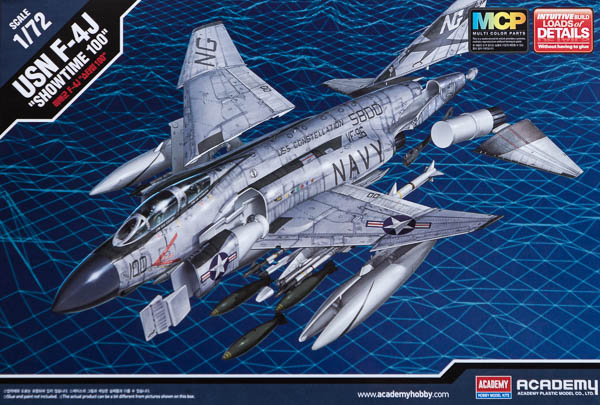
Academy 1/72 USN F-4J Phantom II "Showtime 100"
By Chris Banyai-Riepl
Overview
The McDonnell Douglas F-4 Phantom has had a long career, and it continues to be told with several nations still flying the type. In US service, the Phantom is probably best known for its role during the Vietnam War, where the type was operated by the US Air Force, the US Marines, and the US Navy. During that conflict, the Phantom held its own, working both the air-to-ground and air-to-air roles, with several racking up notable MiG kills.
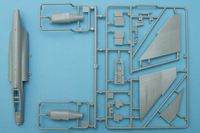
The Kit
As famous a plane as the F-4 is, it has been a while since we have seen a new-tool Phantom in 1/72. The Hasegawa kits have long been the go-to choice for a Phantom in this scale, but now Academy is giving them a run for the money. This latest kit is a bit of an oddity in that it comes molded in three colors and features stickers, but also has extensive detailing with petite recessed rivets and panel lines and lots of options along with a comprehensive set of decals. There are other peculiarities as well that will crop up in assembly, but in the end this will likely be the best 1/72 F-4J on the market today.
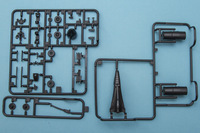
As with most aircraft kits, construction starts with the interior. This one is rather well detailed. Right off, though one of those odd items shows up. The control column and rudder pedals for the front office fit onto a separate floor piece that is then inserted into the one-piece tub. It makes no sense why that piece is separate, but hopefully the seat will cover up the potential seam that might result. For the back cockpit, there are extra bits to make an accurate USN cockpit. The center bulkhead and rear bulkhead are also separate. The seats are made up from four parts and look the part, although they do lack seat belts. The instrument panels are also well detailed, with petite raised detail that matches the sidewall detail.
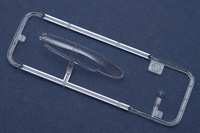
The cockpit tub fits into a one-piece upper fuselage component that is nicely molded and eliminates the need for a seam along the fuselage top. There's a rear bulkhead to fit around the exhaust pipes, and four large, solid locating lugs to match up with large pins on the lower wing piece. The instrument panel hood is separate, with a separate gunsight glass. Back to the lower wing piece, this gets the two exhaust cans, which are one piece and about an inch deep with both internal and external detail. Back to oddities, there is a separate insert for the back of the nose wheel well. This gives some nice detail for the back wall of the wheel well, but oddly, similar treatment was not given to the front wall.
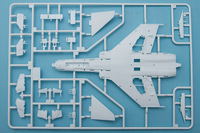
With the lower wing in place on the upper fuselage piece, and the separate rear exhaust hot section added, the next step is the intakes. These are always challenging for models, as there is some complex structures here with splitter plates, vanes, and long trunks. This kit seems to have tackled this well, with a two-piece main trunk assembly and a long separate splitter plate. The engine face completes the assembly, and then these two intakes slide into the fuselage assembly. There's the usual intake seam on the fuselage as a result, but this is found on pretty much every Phantom kit so we're used to it.
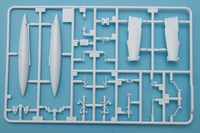
The remaining major assembly is as one would expect. The nose cone (molded in black, of course) is separate, as are the stabilizers. The upper wing pieces include the outer panels. The vertical fin is separate, and it features a separate fin cap as well. All of these separate parts allow for easy replacement for alternate variants, everything from the early F-4B all the way through to the long-nosed F-4E/F/G. Even the reconnaissance Phantoms would be possible given the breakdown, so hopefully we will see all of those down the road.
The landing gear is nicely detailed, with the main wheels split into right and left halves and the gear legs featuring separate retraction arms. The nose gear is also well done, with separate oleo scissors and retraction arm, as well as a separate gear door mount. The other gear doors, as well as all the other flaps and vent covers, all have very positive mounting mechanisms that will eliminate any alignment issues. Before turning to the stuff hanging under the wings, the final step is adding the canopy, and here is another oddity: this kit comes with only a closed canopy option. Given the detail provided in the cockpit, it would seem logical to provide an open canopy to show it off. Given the structure of the Phantom canopy, this also becomes challenging to produce as an aftermarket option, as the framing does not lend itself well to a simple vacuform replacement.
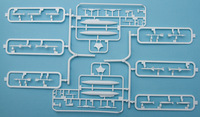
For underwing stores, this kit comes with a full load. You get four AIM-9 Sidewinders, six Mk 82 bombs mounted to TERs, four AIM-7 Sparrow missiles for the fuselage recesses, and a full set of fuel tanks including the two wing tanks and the big 600-gallon centerline tank. The inner pylons are set up to require the TERs, so if you want to do a straight MIGCAP F-4 you'll have to trim off the large pegs for those TERs. Likewise if you want to add a set of bombs on the centerline, you'll need to find a pylon.
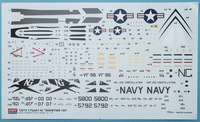
For markings, this boxing comes with VF-96 F-4Js, with two slight variations. Very slight, as while the aircraft are different, they are both the aircraft of Randy Cunningham. The first one is the well-known BuNo 155800, #100 from May 10, 1972, which features a MiG kill marking on the vertical fin and colorful markings on the fuselage center. The second option is almost identical, but is BuNo 155792, #107 from March 1972. The decal sheet provides lots of stenciling, which is essential to producing a realistic-looking Phantom. For those who want to use the stickers, only 5800 is provided, and there is no stenciling provided.
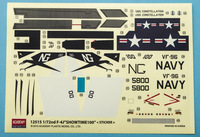
Conclusion
Despite the oddities in color, construction, and stickers, this is the best 1/72 F-4J we currently have available. Undoubtedly we will see lots of aftermarket decal options for this soon, as Navy Phantoms offer some colorful options, and hopefully before long we'll see Academy release an F-4B/N and tackle some of the Air Force variants. My thanks to MRC for the review sample.
